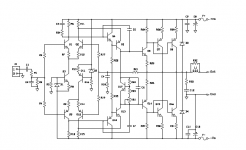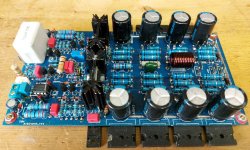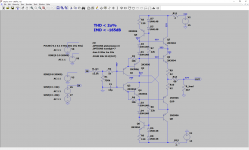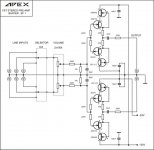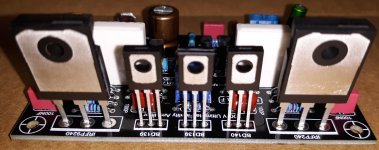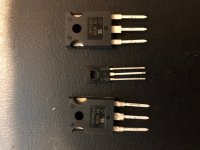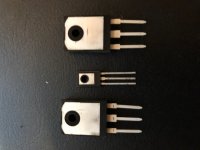anyone have Apex AX14 LTSpice file?
Try this
Attachments
Can anyone suggest a good Diamond Buffer (with or without onboard volume pot) where the gerbers or perhaps even the Eagle or KiCad or pcbCAD720 files are available and sharable?
I would like to order from jlcpcb.com and make a good Diamond Buffer to put after my volume potentiometers for my DIY amplifiers which have sufficient gain to not require a pre-amplifier. So far I have been experimenting with breadboard based 2SC2240/2SA970 and KTC1845/KSA992 Diamond Buffers.
I would like to order from jlcpcb.com and make a good Diamond Buffer to put after my volume potentiometers for my DIY amplifiers which have sufficient gain to not require a pre-amplifier. So far I have been experimenting with breadboard based 2SC2240/2SA970 and KTC1845/KSA992 Diamond Buffers.
To all friends here in the forum especially in APEX AUDIO of Sir WILLY CERNA Im Sorry to till you that he past away we pray for him
Hello, APEXAUDIO. Tell me please what is the optimal supply voltage for APEX SR200? And will PSU10 pull two channels of this amplifier?
Yuriy64
Юрий, хотя тут принято писать на английском, зачем дважды делать перевод. Есть два варианта питания до 45V и от 50-75V. Во всех диапазонах он работает. У меня лично работает +-75V на 8Ом. Питание Тор. На один канал один стабилизатор. (PSU) 2х20000Uf в плечо. Хотя он отлично и без них работает.
___________________________________________
 This is an English language forum, You must post in English. Posting in any other language is not allowed unless you provide a complete translation into English. This is made clear in the RULES.
This is an English language forum, You must post in English. Posting in any other language is not allowed unless you provide a complete translation into English. This is made clear in the RULES.
Юрий, хотя тут принято писать на английском, зачем дважды делать перевод. Есть два варианта питания до 45V и от 50-75V. Во всех диапазонах он работает. У меня лично работает +-75V на 8Ом. Питание Тор. На один канал один стабилизатор. (PSU) 2х20000Uf в плечо. Хотя он отлично и без них работает.
___________________________________________
 This is an English language forum, You must post in English. Posting in any other language is not allowed unless you provide a complete translation into English. This is made clear in the RULES.
This is an English language forum, You must post in English. Posting in any other language is not allowed unless you provide a complete translation into English. This is made clear in the RULES.
Last edited by a moderator:
Hello, APEXAUDIO. Tell me please what is the optimal supply voltage for APEX SR200? And will PSU10 pull two channels of this amplifier?
Use PSU15 for two channels, set +/-65V.
Studio Reference Amplifier
To all friends here in the forum especially in APEX AUDIO of Sir WILLY CERNA Im Sorry to till you that he past away we pray for him
So sorry to hear that. May his soul rest in peace. Artistic PCB designer.
Yuriy64
Fix our mistake.
Yuri, although it is customary to write in English, why do the translation twice. There are two options for eating up to 45V and from 50-75V. It works in all ranges. I personally work + -75V on 8Ohm. Eating Thor. One stabilizer per one channel. (PSU) 2x20000Uf into the shoulder. Although he works well without them.
Fix our mistake.
Yuri, although it is customary to write in English, why do the translation twice. There are two options for eating up to 45V and from 50-75V. It works in all ranges. I personally work + -75V on 8Ohm. Eating Thor. One stabilizer per one channel. (PSU) 2x20000Uf into the shoulder. Although he works well without them.
Hello, APEXAUDIO. Thanks for the good decision. SR200! True, the size of the standard fee was small for us. We have developed another version of the PCB. Your fee. They worked everything first on the simulator. Assembled and launched. For a year he has been working without complaints. Everything is great!
Attachments
apexaudio SR200 users
SR200. There's a little nuance to this decision. Diodes D3 and D4 it is better to close in heat shrinkage from light ingress. Standing at the entrance LF411. Stability is increased. Otherwise, sometimes floats zero at the exit. And it's worth it iron. Checked on 8 collected different boards.
SR200. There's a little nuance to this decision. Diodes D3 and D4 it is better to close in heat shrinkage from light ingress. Standing at the entrance LF411. Stability is increased. Otherwise, sometimes floats zero at the exit. And it's worth it iron. Checked on 8 collected different boards.
Can anyone suggest a good Diamond Buffer
I can offer such a buffer.
Attachments
Can you share this pcb with us🙂Hello, APEXAUDIO. Thanks for the good decision. SR200! True, the size of the standard fee was small for us. We have developed another version of the PCB. Your fee. They worked everything first on the simulator. Assembled and launched. For a year he has been working without complaints. Everything is great!
Can anyone suggest a good Diamond Buffer (with or without onboard volume pot) where the gerbers or perhaps even the Eagle or KiCad or pcbCAD720 files are available and sharable?
I would like to order from jlcpcb.com and make a good Diamond Buffer to put after my volume potentiometers for my DIY amplifiers which have sufficient gain to not require a pre-amplifier. So far I have been experimenting with breadboard based 2SC2240/2SA970 and KTC1845/KSA992 Diamond Buffers.
All fet buffer
Attachments
Before I turn on this (FH9 based board) can anyone post pictures (front and back) of genuine Siliconix/Vishay IRFP240, IRFP9240? (And ST BD139/BD140?) Or compare my photos with your known real devices from authorized distributors.
I have attached photos of what came with the boards. I am hoping to determine if they are "genuine"/safe before turning it on.
I was also planning to initially test at a low voltage. Would it be a good idea or bad idea to initially turn it on with +/-15V from LM317/LM337 board? I ask since I have run into too many "weak" (fake) power transistors.
If you think they are iffy I will take a slower route and get genuine outputs and drivers from Mouser or Digikey.
I have attached photos of what came with the boards. I am hoping to determine if they are "genuine"/safe before turning it on.
I was also planning to initially test at a low voltage. Would it be a good idea or bad idea to initially turn it on with +/-15V from LM317/LM337 board? I ask since I have run into too many "weak" (fake) power transistors.
If you think they are iffy I will take a slower route and get genuine outputs and drivers from Mouser or Digikey.
Attachments
The Mosfets look real (match my Vishay's from Mouser) and I don't have ST BD139, mine are ON Semi from Mouser. Posted pics of the one's I had on hand.
Only the BD139/140 backs look different, the ON Semi's I have are square corners (I checked the 100 (4 different orders) I have and all the same square corners for BD139 and BD140)
I don't think BD139/140 are so expensive to need fakes, but use a DBT to bring it up and you should be able to tell very quickly if the bias or offset is unstable.
I have built 6 FH11 (same design with 2-pair of outputs) and the bias is rock-solid from start-up to hours of listening.
Only the BD139/140 backs look different, the ON Semi's I have are square corners (I checked the 100 (4 different orders) I have and all the same square corners for BD139 and BD140)
I don't think BD139/140 are so expensive to need fakes, but use a DBT to bring it up and you should be able to tell very quickly if the bias or offset is unstable.
I have built 6 FH11 (same design with 2-pair of outputs) and the bias is rock-solid from start-up to hours of listening.
Attachments
Thank you for the reply and the photos!
Thank you also for the comment on the FH11 amplifier. When I prepare the heatsink I will leave space and drill extra holes on either side for an extra IFRP240 and IRFP9240 pair. That way I can easily later add the second pair with 220 Ohm and 0.22 Ohm resistors soldered to the leads of the extra pair.
My speakers are sold as "8 Ohms" but when I measured them with REW then are clearly 4 Ohms. So I prefer two pairs of outputs.
Thank you also for the comment on the FH11 amplifier. When I prepare the heatsink I will leave space and drill extra holes on either side for an extra IFRP240 and IRFP9240 pair. That way I can easily later add the second pair with 220 Ohm and 0.22 Ohm resistors soldered to the leads of the extra pair.
My speakers are sold as "8 Ohms" but when I measured them with REW then are clearly 4 Ohms. So I prefer two pairs of outputs.
- Home
- Amplifiers
- Solid State
- 100W Ultimate Fidelity Amplifier
